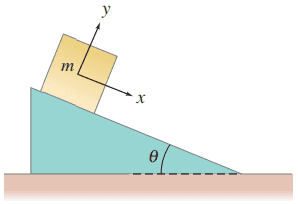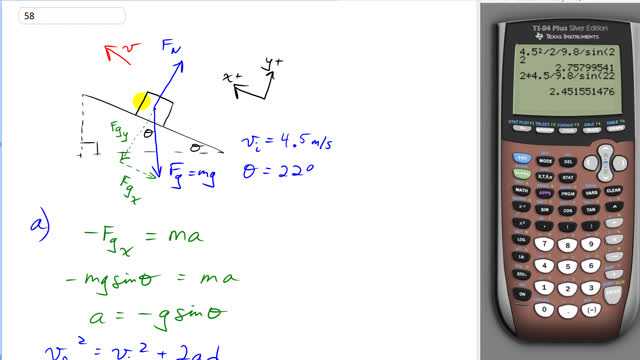
A block is given an initial speed of 4.5 m/s up the plane shown in Fig. 4–59.
- How far up the plane will it go?
- How much time elapses before it returns to its starting point? Ignore friction.


In order to watch this solution you need to have a subscription.
This is Giancoli Answers with Mr. Dychko. This block is given an initial velocity of 4.5 meters per second up the ramp. We'll make that a positive velocity by choosing the x axis to be positive of up the ramp. And there's no friction. So, the only forces are gravity straight down and the normal force perpendicular to the ramp and what we'll be concerned with is the x component of gravity which is slowing this box down. And we'll figure out based on the acceleration that that results in, how far will the blocks go before it comes to a stop. So, the x component of gravity is acting in the negative directions we put negative Fgx and that is the only force horizontally so that makes up the net force which makes it equal to ma. And Fgx being the opposite leg of this gravity force triangle means we have to use ine theta times Fg to get it. But Fg is mg. And so, we have negative mg sine theta equals ma. And then we'll divide both sides by m and we have acceleration as negative g sine theta. And then we could find a number right now if we wanted to but let's instead go over here and figure out using kinematics what a formula would be for the displacement and then we'll substitute this acceleration in down here. So, the final velocity is zero because it comes to a stop at some point up the ramp. And we'll subtract V initial squared from both sides. And then we have 2ad equals negative Vi squared, divide both sides by 2a and we have d is negative V initial squared divided by 2a and a as we know from up here is negative g sine theta so, we'll substitute that in. So, we have displacement is V initial squared over 2 g theta, sine theta. So, that's 4.5 meters per second squared divided by 2 times 9.8 meters per second squared times sine 22 which gives 2.8 meters. And that's how far it'll go before it comes to a stop. And then, how long does it take? Well, how long does it take to get back to its initial position? Which means displacement is zero because it ends where it started. So, <>df<> minus <>di<> or position final minus position initial is zero so, that's this placement, none. Which makes our work a little easier. Equals V initial times time plus 1/2 at squared. Well, we can divide both sides by t. 0 divided by t is just 0. And V initial, t over t is V initial. And we'll also subtract that or move that term to the other side and switch the sides around and we have 1/2 at equals negative Vi. The t squared turns into just t when you divide by t squared by t. And then we'll multiply by 2 over a. And we have t is negative 2 times V initial over acceleration and acceleration is negative g sine theta as we know from up there. So, we have the time is negative 2 times V initial divided by negative g sine theta which is 2 Vi over g sine theta. And so, the time to go from a starting point back to a starting point, so, one round trip, is 2 times 4.5 meter per second divided by 9.8 meter per second squared times sine 22 which is 2.5 seconds.
how did we get to sin 22
Hi jolieamante, thank you for your question. At 0:56 I explain that we need the x-component of gravity, or in other words, the component of gravity along the ramp. This x-component is opposite the angle , which is equal to the angle of incline of the ramp given to us in the question, which results in the x-component of gravity being .
Hope that helps,
Shaun